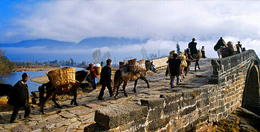
Xishuangbanna Tea Fields
.jpg)
Overview:Located in China's Yunnan Province, the county of Xishuangbanna is world-famous for its puer tea. Puer tea is a post-fermented tea which is famous for its rich flavor and aroma.
Located in China's Yunnan Province, the county of Xishuangbanna is world-famous for its puer tea. Puer tea is a post-fermented tea which is famous for its rich flavor and aroma. The tea improves with tea, making it a favorite with collectors and investors and many people purchase the tea to age it. The tea got its name from Puer County which used to be a traditing center for the tea.
There are two basic types of Puer Tea, Sheng Puer and Shu Puer. Sheng Puer, often called “Raw Puer”, and Shu Puer is often called “Ripe Puer”. New Sheng Puer is often bitter and as it ages, the bitterness fades and the tea takes on a complexity of flavor and aroma. The aged Puer is highly desired and sought after, but it is quite rare and very expensive, so in 1972, tea farmers in Xishuangbanna decided to try to replicate the flavor and aroma of the aged Sheng Puer. The result was Shu Puer. Although not terribly close to the taste of aged Sheng Puer, it is much smoother and richer in flavor. The change of taste is brought on by controlled fermentation of the leaves before they are shaped.
The processing of Puer Tea is very complicated and requires an expert tea master to ensure that the entire year’s crop is not ruined. Each step has to be carefully monitored and a single misstep ruins the entire batch. The tea is picked and handled very carefully to ensure that the leaves are not bruised which would cause oxidation and change the entire end result. The leaves are then wilted, either outside, weather permitting, or in ventilated rooms. This removes some of the water content. If it is a particularly humid day, the leaves can be wilted with the help of heat lamps. The leaves are then fried in large woks. This stops any oxidation. The leaves are then rolled and shaped. Once shaped, the leaves are dried and any irregular or bad leaves are removed. Once fully dried, the tea is then quickly steamed before being pressed into shape. Most Puer is compressed into a shape, but some is not and is left as loose leaf tea. For Shu Puer, the difference is that before frying the leaves, they are wetted and piled under blankets to ferment.
Compressed Puer Tea takes on many different shapes. The most common being; cake (Bing), bowl (Tuo), and brick (Zhuang). Traditionally, the tea, after being dried, would be steamed for a few seconds to soften it and then it would be placed in a bag and pressed between stones. Now, hydraulic presses are used. Before pressing, a piece of paper is generally added to the tea to identify it if the outer wrapper is ever lost. Puer cakes (Puer Bing) are created by putting the loose leaf puer into a cloth bag. The bag is placed over steam for a few seconds, the top of the bag is tied into a knot to keep the leaves from falling out and it is pressed. The knot is pushed into the tea, making a simple in the back of them. The other forms of compressed shapes are generally created the same way, except for bricks (zhuang), which do not use the cloth bags. After compression, the teas are placed on racks for a final drying before they are wrapped in paper wrappers. There are some compressed puer teas which are made only for decoration. They can be shaped like stone lions, calligraphy, and paintings. They are generally made with inferior tea leaves, very higly compressed and glue is added to ensure they keep their shape. Without the glue, humidity can make the tea swell, ruining the design.
Puer Tea is prized and visiting Xishuangbanna to see how the tea is grown and produced is a wonderful addition to all China tours. There are many places where visitors can go and take part in the tea production.
Top Yunnan Tours
- 14-day Kunming Pu’er Jinghong Dali Yunnan Tea Business Trip
- 18-day Shanghai Hangzhou Xian Chengdu Yunnan Guilin Hong Kong Tour
- 20-day Chengdu Yunnan Guizhou Guilin Hong Kong Tour
- 14-day Beijing Xian Chengdu Yunnan Tour
- 10-day China Tea Horse Road Tour
- 8-day Kunming Dali Lijiang & Lugu Lake Tour
- 7-day Kunming Jianshui Yuanyang Hekou Yunnan Vietnam Tour
- 8-day Yunnan Kunming Pu’er Xishuangbanna Tea Tour


